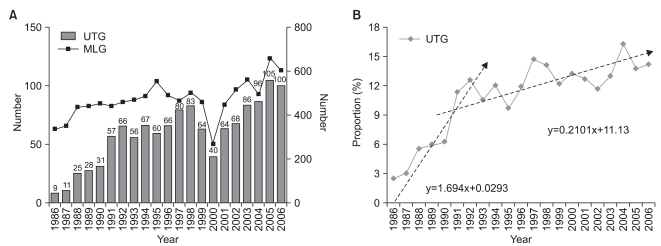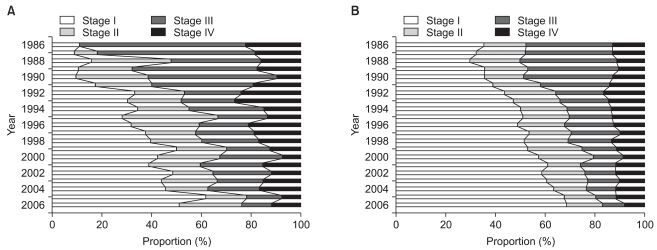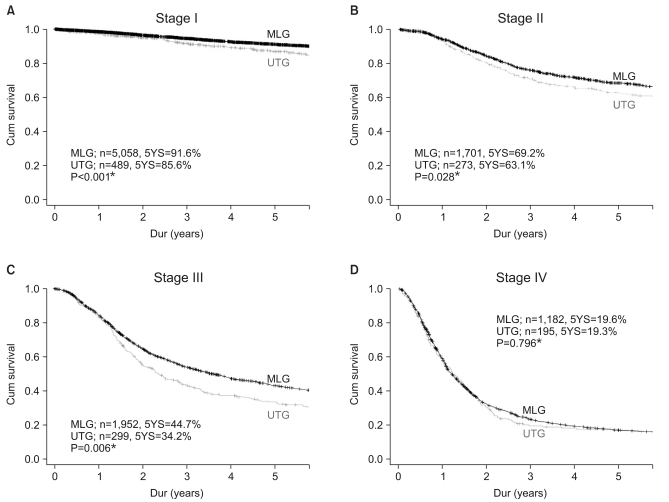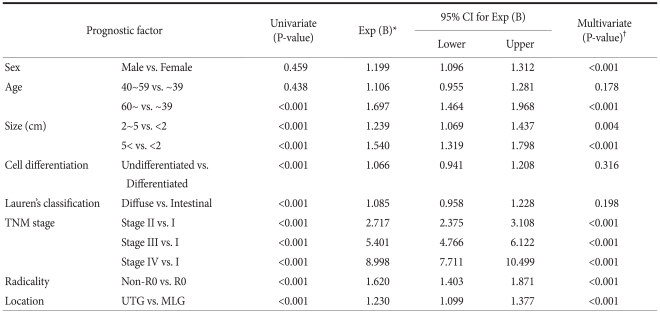1. Parkin DM, Bray F, Ferlay J, Pisani P. Global cancer statistics, 2002. CA Cancer J Clin. 2005; 55:74–108. PMID:
15761078.

2. Hassan HA, Sharma VK, Raufman JP. Changing trends in gastric carcinoma at a university medical center: a twelve-year retrospective analysis. J Clin Gastroenterol. 2001; 32:37–40. PMID:
11154167.
3. Blaser MJ, Saito D. Trends in reported adenocarcinomas of the oesophagus and gastric cardia in Japan. Eur J Gastroenterol Hepatol. 2002; 14:107–113. PMID:
11981333.

4. Zhou Y, Zhang Z, Zhang Z, Wu J, Ren D, Yan X, et al. A rising trend of gastric cardia cancer in Gansu Province of China. Cancer Lett. 2008; 269:18–25. PMID:
18501504.

5. Ryu KW, Kim CS, Goo BH. Clinicopathologic characteristics of and prognosis for proximal gastric carcinomas. J Korean Surg Soc. 2000; 59:223–228.
6. Park MW, Bae JM, Kim SW, Kim SW, Song SK. Annual change of clinicopathologic characteristics after radical gastrectomy due to gastric cancer. J Korean Surg Soc. 2009; 77:88–95.

7. Yang HK. The Information Committee of the Korean Gastric Cancer Association. Current status of clinical practice for gastric cancer patients in Korea. J Korean Gastric Cancer Assoc. 2004; 4:95–108.
8. Bruno L, Nesi G, Montinaro F, Carassale G, Lassig R, Boddi V, et al. Clinicopathologic findings and results of surgical treatment in cardiac adenocarcinoma. J Surg Oncol. 2000; 74:33–35. PMID:
10861606.

9. Talamonti MS, Kim SP, Yao KA, Wayne JD, Feinglass J, Bennett CL, et al. Surgical outcomes of patients with gastric carcinoma: the importance of primary tumor location and microvessel invasion. Surgery. 2003; 134:720–727. PMID:
14605635.

10. Kim DY, Joo JK, Ryu SY, Park YK, Kim YJ, Kim SK. Clinicopathological characteristics and prognosis of carcinoma of the gastric cardia. Dig Surg. 2006; 23:313–318. PMID:
17164543.

11. Kunisaki C, Akiyama H, Nomura M, Matsuda G, Otsuka Y, Ono H, et al. Surgical outcomes for early gastric cancer in the upper third of the stomach. J Am Coll Surg. 2005; 200:15–19. PMID:
15631915.

12. Kim WH, Park CK, Kim YB, Kim YW, Kim HG, Bae HI, et al. A standardized pathology report for gastric cancer. Korean J Pathol. 2005; 39:106–113.
13. Nakamura K, Sugano H, Takagi K. Carcinoma of the stomach in incipient phase: its histogenesis and histological appearances. Gann. 1968; 59:251–258. PMID:
5726267.
14. Lauren P. The two histological main types of gastric carcinoma: diffuse and so-called intestinal-type carcinoma. an attempt at a histo-clinical classification. Acta Pathol Microbiol Scand. 1965; 64:31–49. PMID:
14320675.
15. Tamura G, Sato K, Akiyama S, Tsuchiya T, Endoh Y, Usuba O, et al. Molecular characterization of undifferentiated-type gastric carcinoma. Lab Invest. 2001; 81:593–598. PMID:
11304579.

16. Frederick LG, Charles MB, David IP, Daniel GH, Irvin DF, Monica M, April GF, editors. AJCC Cancer Staging Manual. Vol 1. 2002. 6th ed. New York: Springer-Verlag.
17. The Information Committee of the Korean Gastric Cancer Association. 2004 nationwide gastric cancer report in Korea. J Korean Gastric Cancer Assoc. 2007; 7:47–54.
19. Sasako M, Sano T, Yamamoto S, Sairenji M, Arai K, Kinoshita T, et al. Left thoracoabdominal approach versus abdominaltranshiatal approach for gastric cancer of the cardia or subcardia: a randomised controlled trial. Lancet Oncol. 2006; 7:644–651. PMID:
16887481.

20. Piso P, Werner U, Lang H, Mirena P, Klempnauer J. Proximal versus distal gastric carcinoma--what are the differences? Ann Surg Oncol. 2000; 7:520–525. PMID:
10947021.

21. Maeda H, Okabayashi T, Nishimori I, Sugimoto T, Namikawa T, Dabanaka K, et al. Clinicopathologic features of adenocarcinoma at the gastric cardia: is it different from distal cancer of the stomach? J Am Coll Surg. 2008; 206:306–310. PMID:
18222384.

22. McColl KE. Cancer of the gastric cardia. Best Pract Res Clin Gastroenterol. 2006; 20:687–696. PMID:
16997153.

23. Hamilton SR, Aaltonen LA, editors. . Pathology and Genetics of Tumours of the Digestive System. 2000. 1st ed. Lyon: IARCPress;p. 281–292.
24. Ectors N, Driessen A, De Hertog G, Lerut T, Geboes K. Is adenocarcinoma of the esophagogastric junction or cardia different from Barrett adenocarcinoma? Arch Pathol Lab Med. 2005; 129:183–185. PMID:
15679417.

25. Sakaguchi T, Watanabe A, Sawada H, Yamada Y, Tatsumi M, Fujimoto H, et al. Characteristics and clinical outcome of proximal-third gastric cancer. J Am Coll Surg. 1998; 187:352–357. PMID:
9783780.

26. Yokoi C, Gotoda T, Hamanaka H, Oda I. Endoscopic submucosal dissection allows curative resection of locally recurrent early gastric cancer after prior endoscopic mucosal resection. Gastrointest Endosc. 2006; 64:212–218. PMID:
16860071.










 PDF
PDF ePub
ePub Citation
Citation Print
Print


 XML Download
XML Download